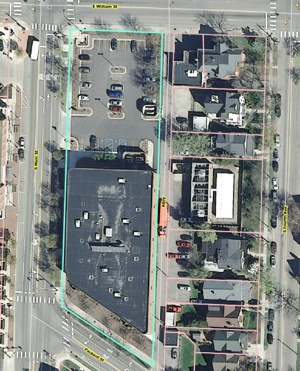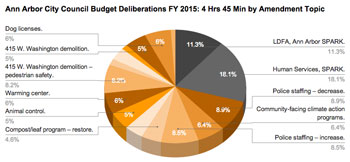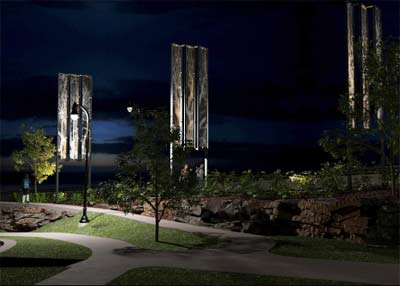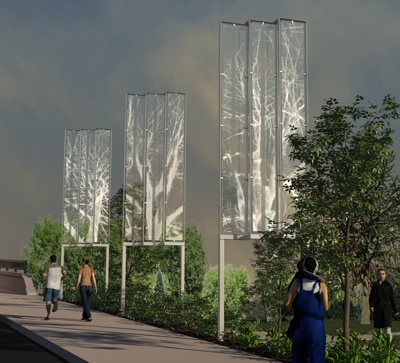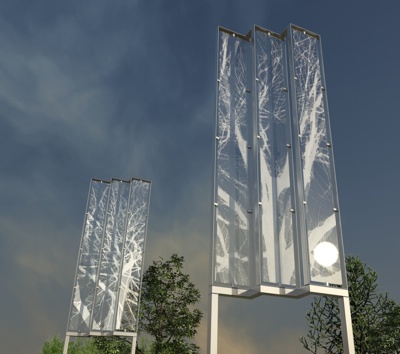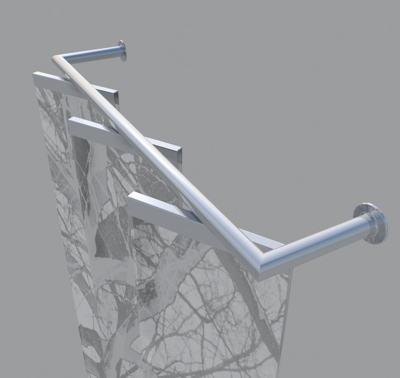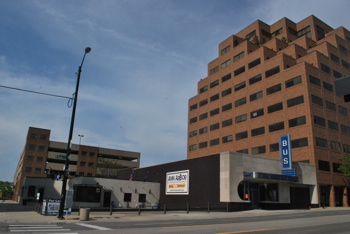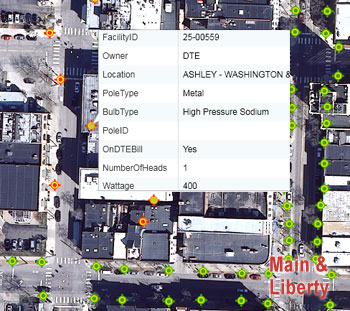Planning Group Grants Jesuit Request
On a 7-1 vote, the Ann Arbor planning commission has cleared the way for a group of up to six members of the Ann Arbor Jesuit Community to live in a single-family home at 1919 Wayne St. The action came at the commission’s June 17 meeting, when commissioners reconsidered an item that they had initially rejected on June 3, 2014.
The meeting included a public hearing that lasted about an hour, with the majority of speakers supporting the request. More than 100 people attended the meeting, many of them wearing stickers that stated “I Proudly Support The Jesuits.”
The Jesuits had requested a special exception use to allow a “functional family” to live in a house zoned R1C (single-family dwelling). Without the special exception use, only up to four unrelated people could live there.
The code that allows this special exception use was adopted by Ann Arbor in 1991. Although the city’s ordinance has allowed for a “functional family” designation for more than two decades, this is the first time any group has requested it. The members are affiliated with the St. Mary Student Parish.
Approval requires six votes, but on June 3 the request had garnered support from only five of the seven commissioners who were present. Voting against it were Diane Giannola and Kirk Westphal. Two commissioners – Sabra Briere and Paras Parekh – had been absent. An attempt earlier in that meeting to postpone the vote had failed, with a majority of commissioners wanting to take action that night, apparently assuming it would pass. Later in that June 3 meeting, after the item had been rejected then reconsidered, the commission took another vote to postpone. That vote was 6-1, over dissent from Giannola.
Giannola again dissented on June 17 to the special exception use, but the remaining seven commissioners at the meeting –including Westphal – supported the request. Jeremy Peters was absent.
The planning commission has discretion to grant a special exception use, which does not require additional city council approval.
The commission’s action on June 3 had come after about an hour of a public hearing and two hours of deliberations. Of the 21 people who spoke at that time, the majority were opposed to the request, including representatives from the Oxbridge Neighborhood Association and the North Burns Park Association. Concerns included the possibility of lower property values, the chance of opening the door to student housing or cults, instability of the household because members aren’t related, and “gender housing discrimination.”
Some people directed criticism against the power, privilege and abuse of the Catholic church. Other praised the Jesuits, saying their concerns were strictly related to the zoning code, which they didn’t feel permitted this type of living arrangement in the R1C district. They suggested that the Jesuits could live in other districts – like R4C – that would allow for up to six unrelated people to live together without getting a special exception use.
The public hearing was continued on June 17, and this time drew considerably more supporters of the request. Of the 23 speakers on June 17, 16 supported the Jesuits’ request. Some of the speakers who opposed granting the Jesuits a special exception use as a “functional family” said they’d support it for a church purpose, noting that the Jesuits would be using it as a parsonage.
The commission had also received more than 75 emails/letters over the past two weeks, the vast majority of them in support of granting the special exception use. About 50 of those communications were attached to the commission’s online agenda.
Assistant city attorney Kevin McDonald attended the June 17 meeting and fielded questions from commissioners. The resolution was amended slightly, with an intent to emphasize the long-term relationship of the Jesuits to each other.
The property is located in Ward 2. Both of the Ward 2 city councilmembers – Jane Lumm and Sally Petersen– attended the June 17 the planning commission meeting, but did not formally address the commission. The planning commission’s decision is final – as the request from the Jesuits does not need city council approval. Westphal – the planning commission’s chair – is running for city council in the Ward 2 Democratic primary. Westphal and Nancy Kaplan are vying to fill the open seat that’s being left by Sally Petersen’s mayoral candidacy. Councilmember Sabra Briere, who serves on the planning commission, is also running for mayor.
After the vote, members of the audience erupted in applause. One woman approached Ben Hawley, pastor and director of campus ministry for St. Mary Student Parish, saying: “Welcome to the neighborhood!”
This brief was filed from the second-floor council chambers at city hall. A more detailed report will follow: [link]




